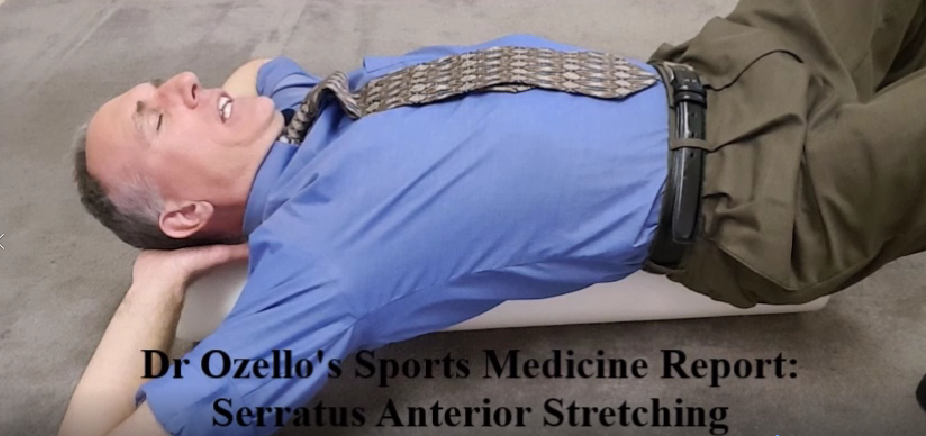Stretch the Serratus Anterior muscle to improve posture, increase shoulder, ribcage and spine health and improve upper body function. Hold a mild comfortable stretch in the serratus anterior muscle for five to one hundred and twenty seconds to decrease muscle tension and improve flexibility. Perform serratus anterior stretches while seated, supine, laying supine on a BOSU ball and in a supine position on a foam roller. Execute serratus anterior stretches while hanging from a pull-up bar or while standing to decrease muscle tension and improve shoulder motion. Perform serratus anterior stretches to help prevent and rehabilitate postural impairments named upper cross syndrome and scapular dyskinesis.
Serratus Anterior Muscle (AKA Boxer’s Muscle)
Origin: First eight or nine ribs. Muscle branches (AKA Slips). Two slips from 2nd rib, one slip from all other ribs.
Attachment: Anterior medial border of scapula.
Innervation: Long Thoracic Nerve from brachial plexus roots C5. C6 and C7.
Actions: Scapular protraction, stabilization of scapula and assist in upward rotation of scapula.
Supine Serratus Anterior Stretch
Supine. Hips flexed, Knees flexed. Feet flat on floor.
Spine straight. Back of head contacting floor. Scapulae contacted floor.
Fingers interlaced behind head.
Let elbows gradually fall toward floor.
Hold a mild comfortable stretch in the serratus anterior for five to one hundred and twenty seconds. Move out of the stretch slowly and repeat several times.
Standing Serratus Anterior Stretch
Standing good posture. Place one hand behind head.
Place medial upper arm and forearm against a solid structure such as a door frame.
Slowly lean forward and gradually rotate to the opposite side.
Hold a mild comfortable stretch for five to one hundred and twenty seconds.
Move out of the stretch slowly.
Perform on opposite side.
Enhance upper body function by stretching the serratus anterior muscles. Execute supine serratus anterior stretches and standing serratus anterior stretches. Move into a stretch slowly, hold a mild comfortable stretch and move out of the stretch slowly. Perform all stretches through a symptom free range of motion. Never execute a stretch that elicits or intensifies symptoms. If a stretch elicits or intensifies symptoms, stop immediately and find a viable substitute.
Disclaimer: Viewing this video does not take the place of seeing a medical professional, receiving proper training in the medical profession or working with a fitness professional. Please visit a medical professional for evaluation, diagnosis and treatment. Please work with a fitness professional to learn proper exercise technique and to develop a proper training program. Never perform an exercise that elicits or intensifies symptoms. If an exercise elicits or intensifies symptoms, stop immediately and use a viable substitute. Please receive proper medical training before attempting these medical procedures.
Dr Donald A Ozello DC of Championship Chiropractic in Las Vegas, NV
Web Site: http://www.championshipchiropractic.com/
Blog: https://www.championshipchiropractic.com/wordpress/
Twitter: https://twitter.com/drdozellodc
Facebook: https://www.facebook.com/Championship-Chiropractic-280141628688300/
LinkedIn: https://www.linkedin.com/in/dr-donald-a-ozello-dc-716b3233
YouTube: https://www.youtube.com/user/drdozellodc/videos
“Running: Maximize Performance & Minimize Injuries” https://www.amazon.com/Running-Performance-Chiropractors-Minimizing-Potential/dp/1493618741

